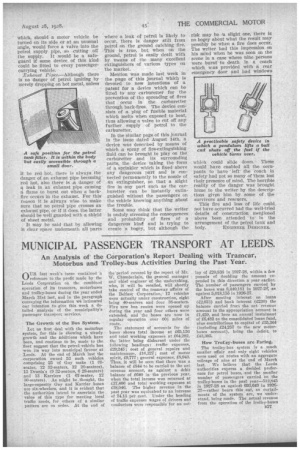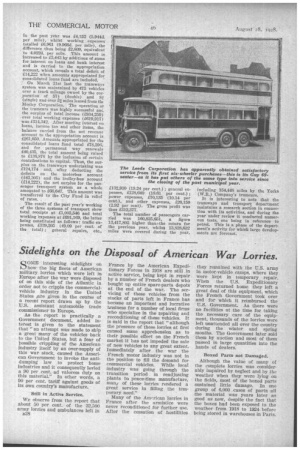MUNICIPAL PASSENGER TRANSPORT AT LEEDS.
Page 11

Page 12

If you've noticed an error in this article please click here to report it so we can fix it.
An Analysis of the Corporation's Report Dealing with Tramcar, Motorbus and Trolley-bus Activities During the Past Year.
O'LIR last week's issue contained a reference to the profit made by the Leeds Corporation on the combined operation of its tramcars, motorbuses and trolley-buses during the year ended March 31st last, and in the paragraph conveying the information we intimated our intention to give this week a detailed analysis of the municipality's passenger transport services.
The Growth of the Bus System.
Let us first deal with the motorbus system, for this is showing a steady growth and the additions which have been, and continue to be, made to the fleet suggest that the petrol vehicle has won its way into municipal favour at Leeds. At the end of March last the corporation owned 53 such vehicles comprising 25 of Guy make (1 09seater, 12 32-seaters, 12 20-seaters), 15 Dennis's (9 32-seaters, (3 28-seaters) and 13 Karriers (1 67-seater, 12 30-seaters). As might be thought, the large-capacity Guy and Karrier buses are six-wheelers, and it is evident that the authorities intend to ascertain the value of this type for meeting local traffic needs, for others of a similar pattern are on order. At the end of
the' period covered by the report of Mr. W. Chamberlain, the general manager and chief engineer of the undertaking, who, it will be recalled, will shortly take control of the tramway affairs of the Belfast Corporation, 12 vehicles were actually under construction, eight being 40-seaters and four 38-seaters. Five new bus routes were opened up during the year and four others were extended, and the buses are now in regular operation over 60i miles of route.
The statement of accounts for the buses shows total income at £65,136 and total working expenses at 164,292, the latter being disbursed under the following headings: traffic expenses, £29,245; cost of general repairs and maintenance, £16,327; cost of motor spirit, £9,777; general expenses, £8,943. Thus, it will be seen that there was a balance of £844 to be carried-to the net revenue account, as against a debit balance of £640 in the previous year, When the total income was returned at £37,406 and total working expenses at 08,046. The higher revenue in the past year was equivalent to an increase of 74.13 per cent. Under the heading of traffic expenses wages of drivers and conductors were responsible for an out lay of 120,836 in 1927-28, within a few pounds of doubling the amount expended in this direction a year earlier. The number of passengers carried by the buses was 8,440,181 in 1927-2g, as against 5,018,155 in 1926-27.
After meeting interest on loans (£2,073) and bank interest (£230) the balance carried from the net revenue account to the appropriation account is 11,459, and here an annual instalment of £6,482 to the consolidated loans fund, plus contributions to capital of £35,364 (including 124,257 to the new motorbuses account), bring the deficit to £43,305.
How Trolley-buses are Farina.
The trolley-bus system is a much smaller affair and only eight vehicles were used on routes with an aggregate mileage of nine at the end of March last. We believe that • the Leeds authorities express a decided preference for petrol buses, and the smaller number of passengers carried on the trolley-buses in the past year-512,845 in 1927-28 as against 693,649 in 19627—rather bears this out, as curtailments of the system are, we understand, being made. The actual revenue from the operation of the trolley-buses
iu the past year was 14,152 (5.944d, pei mile), whilst working expenses totalled £6,961 (9.966d. per mile), the . difference thus being £2,809, equivalent to 4.022d. per mile. This amount is increased to 13,443 by additions of sums for interest on loans and bank interest and is carried to the appropriation account, which reveals a total deficit of £14,222 when amounts appropriated for consolidated loans fund are included.
' On March 31st last the tramways system was maintained by 475 vehicles over a track mileage owned by the cop ,poration of 57 (double) and 8/ (single) and over 31 miles leased from tin Morley Corporation. The operation co) the tramcars was highly successful anf. the surplus of total income (1934,259) over total working expenses (£619,917) was £314,342. After meeting interest on loans, income tax and other items, the balance carried from the net revenue account to the appropriation account is £261,050. Amounts appropriated for the consolidated loans fund total 178,296, and for permanent way renewals £40,435, the total amount being raised to £136,876 by the inclusion of certain contributions to capital. Thus, the surplus on the tramways undertaking was 1124,174 and, after deducting the deficits on the motorbus account (£43,305) and the trolley-bus. account (£14,222), the net surplus for the passenger transport system as a whole amounted to £66,647. This amount was transferred to the City Fund in relief of rates. .
The result of the past year's working of the three systems of transport show total receipts at 11,003,546 and total working expenses at £691,169, the latter being constituted as follows : traffic expenses, 1.239,303 (49.09 per centt, of the total) ; general repairs, etc., 1132,930 (1924 per cent) ; general expenses, £128,640 (18.61 per cent.) ; power expenses, £70,135 (10.14 per cent.), and other expenses, £20,159 (2.92 per cent). The gross profit was thus £312,377.
Tini total number of passengers carried was 160,825,651, a figure 33,417,802 higher than .'the retutn for the previous year, whilst 13,828,632 miles were covered during the year,
including 154,448 miles by the Yorks (W.R.) Company's tramcars.
It is interesting to note that the tramways and transport department maintains a research section in connection with its activities, and during the year under review it conducted numerous tests, one being in reference to petrol. This is a phase of the department's activity for which large developments are forecast.
































